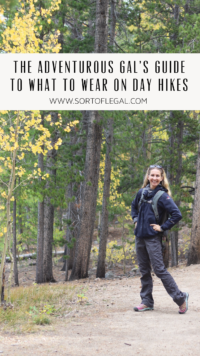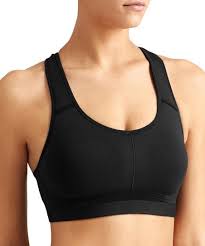
What to Wear on Day Hikes: A Guide for Women
Going on a hike? Not sure what to wear?
You are in the right place.
It’s time to get dressed for hiking success!
Day Hike Outfit Planning Basics
When planning day-hike outfits, think in layers. It provides a framework for choosing your outfit and wearing layers gives you flexibility to adjust your outfit as the weather changes, which it frequently does on bigger day hikes especially at elevation.
When deciding how many layers and what pieces to include in each layer, don’t think in terms of the season. Summer in Banff, Alberta, Canada has wildly different temperatures from summer in Moab, Utah. Instead, think about the specific area and specific hike you are going on. The following are some criteria to consider:
- Average area temperature for the time of year
- Average area precipitation for time of year;
- Length of hike;
- Elevation gain for the hike (more gain = more temperature fluctuation);
- Hike start time and estimated end time;
- Personal preferences (do you run hot or cold?)
Adjust the number of layers and type of clothing based on the anticipated weather and type of hike you are embarking on. When it doubt, pack an extra layer.
When deciding what material clothing to wear, don’t get too bogged down in the details of which technical material to go with. Avoid cotton (“cotton kills!”), shop at outdoor retailers, read the labels (they’ll tell you what the material does – for example, that it is waterproof or for warm weather), and you’ll be a happy and comfortable hiker.
For quick view of my recommendations hiking essentials (clothes and gear) check out my RockPorch (think LTK for outdoorsy stuff):
What Layers to Wear on Day Hikes
If you’re more of a watcher than a reader, here is an admittedly awkward (have to start somewhere!) video I made breaking down exactly what I wear on day hikes. Otherwise, read on!
You can also browse my hiking essentials (clothes and gear) on RockPorch (lthink LTK for outdoorsy stuff):
Undergarments
A sports bra and sport (moisture wicking, quick dry) underwear are the best options for hiking undergarments. Today, there are ample of varieties of both. You can go thong or full-butt on the bottom and padded or unpadded on top.
ExOfficio, SmartWool, & Patagonia are popular brands for hiking underwear. As for sports-bras, there are too many options to list. Generally, whatever sports bra you like for working out will work well for you for hiking. But, if you’re wearing a day-pack, you might not want to go with a sports bra with thick straps because the wight of the bag can cause the straps to dig into your shoulders. Other than that, you do you!
Example Hiking Undergarments
Shop for Women’s Sports Bras & Sport Underwear
Click to Shop Sports Bras on Amazon
Click to Shop Sports Bras on Moosejaw
Click to Shop Sport Underwear on Amazon
Click to Shop Sport Underwear on Moosejaw
Base Layer
Your base layer is the layer that goes over your undergarments. This is an important layer because it’s the one that is in closest contact with your skin. You want something that will wick-sweat away from your body (again, not cotton!) and that is an appropriate weight for your hike (light in hot temps, heavy in cold temps). Anti-microbial/anti-bacterial materials such as wool or silver are nice bonuses.
Two ways to approach your base layer: (1) long john set or (2) top and bottom that you can wear on their own (e.g. hiking pants and a technical material crew neck) or under other pieces when it’s colder. If you think you’ll be shedding layers as the day and your body heat up, I recommend going with a normal top and bottom that way you don’t end up hiking in your long underwear!
I like having both options available, but tend to use long johns more for camping PJs than for hiking.
Example Women’s Hiking Base Layers
Shop for Women’s Hiking Base Layers
Shop Women’s Base Layers on Moosejaw
Shop Women’s Hiking Pants & Tights on Moosejaw
Shop Women’s Hiking Pants & Tights on Amazon
Shop Women’s Hiking Pants & Tights on Columbia.com
Middle (“Mid”) Layer
You really only need a mid-layer top. If you find yourself wearing three layers of pants…it is probably time to invest in some warmer pants! Purpose of mid-layer is to add additional warmth (when needed). A fleece, down, or down alternative jacket or vest are solid mid-layer options.
Look for something that packs down – i.e. that you can shove into your day pack. Massive parkas will keep you warm but their bulkiness makes them hard to move in and even harder to store on a hike if you take it off. And, especially if you go with a down option, don’t forget your waterproof outer layer to avoid water ruining your nice jacket.
Example Women’s Hiking Mid Layers
Shop for Women’s Hiking Mid Layers
Shop Women’s Fleece Jackets on Moosejaw
Shop Women’s Down/Down Alt. Jackets for Hiking on Moosejaw
Shop Women’s Hiking Jackets on Columbia.com
Outer Layer
Your outer layer is generally your wind/rain protection on a hike. The best options are waterproof and breathable. GORE-TEX is the gold standard for a material that does both.
Why waterproof and breathable? Not waterproof = you get wet (full disclosure: I’ve managed with very water resistant jackets + layers on a few rainy hikes). Not breathable = you get sweaty (think: wrestler running in a plastic garbage bag).
Warmth required depends on where you will be hiking and the layers under your outer layer. In a lot of situations, I prefer a thinner outer layer with heavier layers under it. That way I can use the outer layer in warmer temperatures without it being too much.
Example Women’s Outer Layers
Shop for Women’s Outer Layers
Shop Women’s Waterproof Jackets on Moosejaw
Shop Women’s Waterproof Pants on Moosejaw
Socks & Shoes
Blisters, hot spots, and swamp foot are common, painful hiking fun killers. Choosing the right socks and hiking shoes greatly reduces the chances of dealing with these issues.
The ideal hiking sock is moisture-wicking, smell-reducing, and quick drying. Cotton does not meet these requirements (“cotton is rotten!”) Wool does…and like many other hikers, I swear by wool socks, SmartWool socks to be specific. There are other materials that have similar properties, but wool is my favorite.
Hiking shoe choice is very personal. My personal preference is Keen hiking shoes (not boots) for longer hikes and rougher trails and a trail running shoe such as Brooks’ Mazama for shorter hikes on well-groomed trails.
Some people like a full-boot, others a lighter weight shoe. But regardless of the exact type of shoe, look for something that provides stability and traction. You do not want to go hiking in flat bottomed street shoes. I’ve done it…and I’ve fallen on my bum doing it.
Example Women’s Hiking Socks and Shoes
Shop for Women’s Hiking Socks and Shoes
Click to Shop Wool Socks on Amazon
Click to Shop Wool Socks on Moosejaw
Click to Shop Hiking Shoes on Amazon
Click to Shop Hiking Shoes on Moosejaw
WHERE TO BUY HIKING CLOTHES
When it comes to hiking clothes, you don’t need a lot of it, but you do need good stuff. Poor quality hiking gear is uncomfortable at best and dangerous at worst.
Fortunately, it’s pretty easy to find good gear. Shop at reputable outdoor and look for well known outdoor brands. The following are a few spots to look online:
REI (highly recommend becoming an REI member!)
Amazon (Yay Prime! But search for good brands)
Not loving the prices? Shop sales and keep an eye out for good brands at places like TJ Maxx. I found one of my favorite jackets – a Northface – at TJ Maxx! Plan ahead a little and shop in-off season – for example, buying warm weather gear in winter.
Happy Trails! If you’re looking for what to include inside your day-pack, check out The Ten Essentials and Why You Need Them.

















